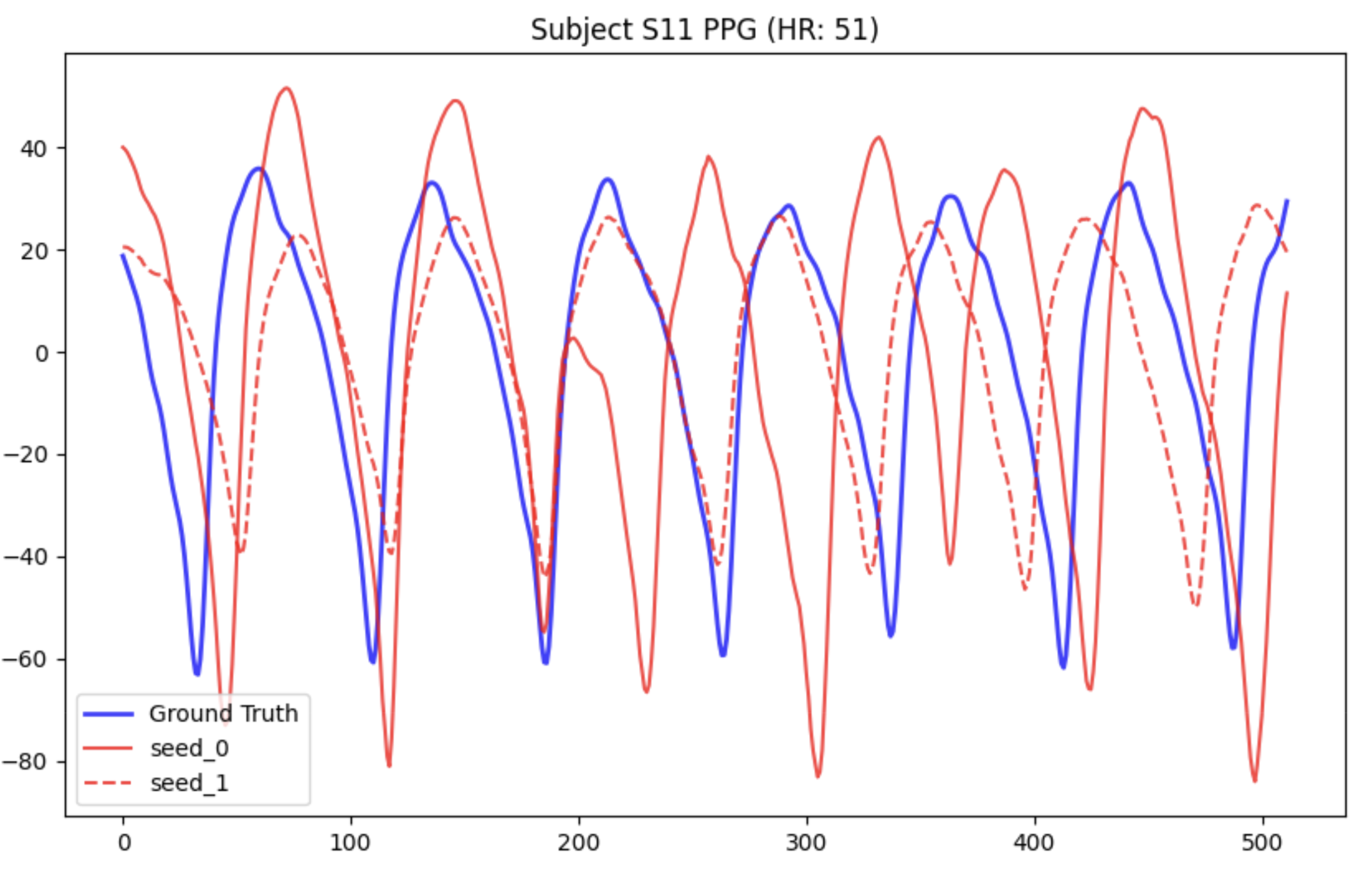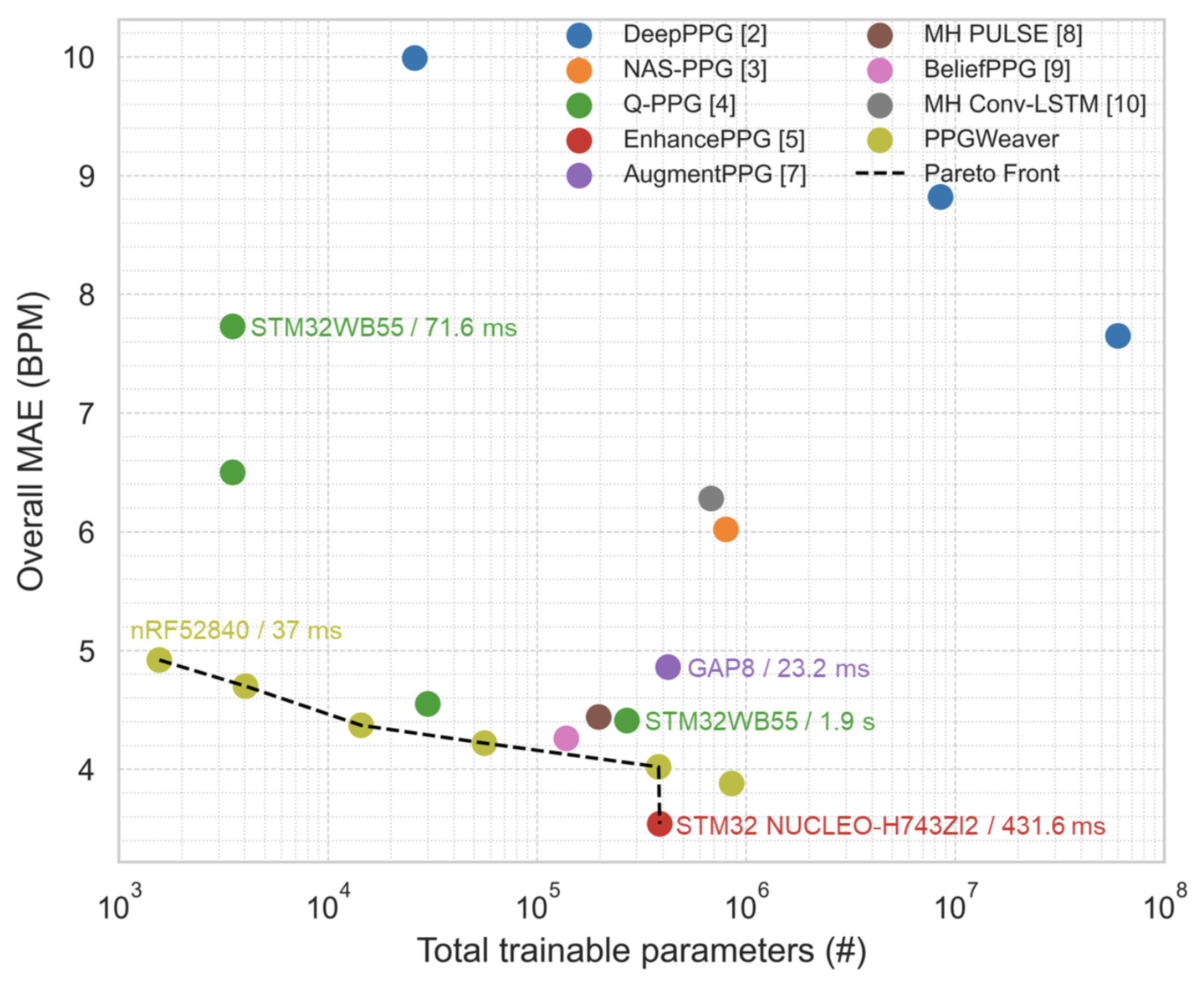What's the Challenge?
Underperforming heart rate sensors in real-world conditions
Heart rate sensors in wearables often fail during intense physical activity or for users with darker skin tones. Optical noise and signal attenuation in photoplethysmography (PPG) lead to inaccurate readings when they matter most—during exercise or health emergencies. This creates accuracy and fairness concerns that limit real-world deployment.
Insufficient training data for rare physiological scenarios
Samsung needed to train models that work across diverse demographics and activity levels, but collecting real-world PPG data for every edge case—high-intensity exercise, various skin tones, rare heart rate patterns—is expensive, time-consuming, and raises privacy concerns.
Ultra-constrained deployment requirements
Commercial wearables run on microcontrollers with kilobytes of memory and strict power budgets. Samsung needed heart rate detection models small enough to run on an ARM Cortex-M4F (64 MHz, 256 KB RAM) with inference latency under 40 ms—while maintaining or improving accuracy. Traditional models required 100k+ parameters and specialized hardware acceleration.
Synthefy's Solution
Synthefy partnered with Samsung Semiconductor to develop TimeGenV1, a conditional generative foundation model that produces realistic PPG waveforms conditioned on metadata such as heart rate, activity type, skin tone, and subject identity.
The solution enabled Samsung to:
- Generate synthetic physiological signals that fill critical gaps in training data—covering rare heart rates, diverse skin tones (Fitzpatrick scale), and high-motion activities without collecting new real-world data
- Train compact Temporal Convolutional Networks (TCNs) augmented with synthetic data, achieving better generalization across underrepresented scenarios like stair climbing and high-intensity exercise
- Deploy on ultra-low-power hardware with a 1.56k-parameter model running real-time inference on bare-metal ARM Cortex-M4F microcontrollers—over 300× smaller than baseline approaches

Figure 1: Synthefy's TimeGenV1 generates realistic PPG signals (orange) that closely match ground-truth test data (blue), while GANs (green) fail to capture high-frequency characteristics typical of motion-heavy or high-HR signals.
State-of-the-art synthetic data quality
TimeGenV1 consistently outperformed GAN-based approaches in both qualitative and statistical evaluations. The synthetic signals matched real PPG distributions in time and frequency domains, enabling Samsung to train models that generalize to previously unseen physiological conditions.

Figure 2: TimeGenV1 (orange) matches ground-truth distribution (blue) in time (left) and frequency (right) domains for unseen test samples, significantly outperforming GANs.
Metadata-conditioned generation for targeted synthesis
By conditioning on heart rate, activity type, and demographic factors, TimeGenV1 enabled Samsung to synthesize specific edge cases. For example, generating high-heart-rate waveforms (≈125 BPM) from a subject who never experienced that heart rate in the training data.

Figure 3: Synthetic PPG data (red) generated by TimeGenV1 preserves periodic structure and amplitude variations at high heart rate, matching real data from a different subject (blue).

Figure 4: Multiple synthetic generations show consistent waveform morphology with natural variability, confirming reliable synthesis across different heart rate conditions.
Synthefy Synthetic Data Improves Samsung's Heart Rate Detection
Samsung tested two training regimes:
- TRTR: Trained on real data only
- TRSTR: Trained on real + synthetic data
Models trained with synthetic augmentation consistently achieved lower Mean Absolute Error (MAE) across all activity types, with dramatic improvements for underrepresented states like stair climbing.

Figure 5: Adding synthetic data (TRSTR) improves heart rate detection accuracy on real, held-out test data across all activity types. The improvement is most dramatic for underrepresented scenarios like 'Stairs'.
Breakthrough in model compression for edge deployment
Using structured pruning, Samsung compressed models from 512k parameters to just 1.56k parameters—achieving over 300× reduction while maintaining accuracy. When trained with TimeGenV1's synthetic data, these tiny models matched or exceeded the performance of much larger baseline models.

Figure 6: TimeGenV1-augmented training establishes a new Pareto frontier for PPG-based heart rate estimation, achieving lower error at dramatically smaller model sizes—enabling deployment on the most constrained edge devices.
Real-time deployment on microcontrollers
Samsung successfully deployed PPGNet-1.56k on an Arduino Nano 33 BLE Rev2 featuring a 64 MHz ARM Cortex-M4F processor—representative of commercial wearable hardware.
The deployment achieved:
- R² = 0.86 correlation between predicted and ground-truth heart rate
- Under 40 ms inference latency per 8-second window
- Below 20 KB memory usage
- Full-precision FP32 (no quantization required)
- Stable real-time performance with no hardware-specific tuning

Figure 7: (a) Strong correlation (R² = 0.86) between MCU-predicted and ground-truth heart rate across subjects. (b) MCU accuracy matches the original model. (c) Real-time inference with <40 ms latency on Subject S7.
A New Benchmark in Edge AI for Healthcare
This collaboration between Samsung and Synthefy moved the Pareto frontier in edge AI—achieving the same or better accuracy with models that are:
- 300× smaller than previous benchmarks
- Fast enough for always-on, real-time monitoring
- Deployable on ultra-low-power microcontrollers without specialized hardware
- More accurate and equitable across diverse demographics and activity levels
Previous PPG-based heart rate models required 100k+ parameters, dedicated DSP blocks, quantization, and inference times exceeding 100 ms. Samsung's TimeGenV1-trained model runs in under 40 ms on bare-metal firmware with no special hardware.
Production-ready synthetic data for real-world deployment
This project demonstrates that synthetic data is production-ready for edge AI applications. TimeGenV1 enabled Samsung to train compact, accurate, and inclusive heart rate models using metadata-aware synthetic augmentation—all deployed on a 64 MHz MCU with kilobytes of memory.
The result: more accurate, fair, and efficient health monitoring—without additional hardware complexity, data collection costs, or privacy concerns.
Enabling Next-Generation Wearables
Synthefy's partnership with Samsung demonstrates how synthetic physiological data can unlock new capabilities in edge AI for healthcare. By generating realistic PPG signals conditioned on demographic and physiological metadata, Samsung was able to train models that are simultaneously smaller, faster, and more accurate than previous benchmarks—making always-on health monitoring viable on the most power-constrained devices.

